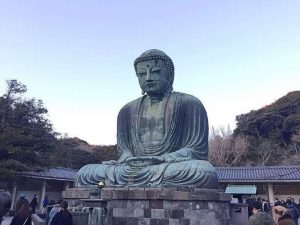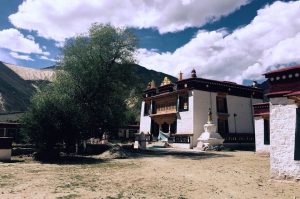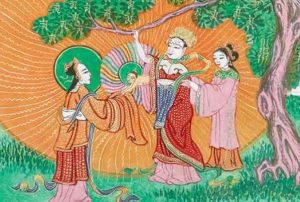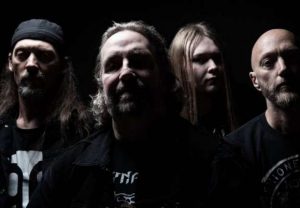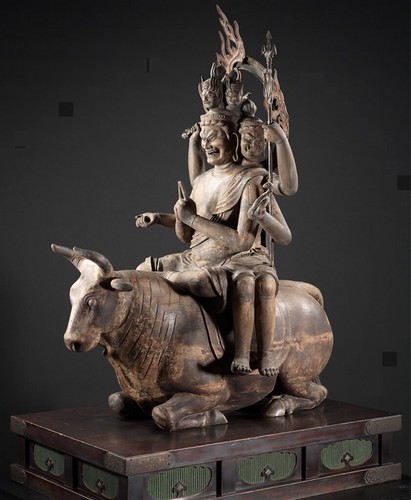
Often overlooked in favor of his more popular counterparts Fudō myōō (Skt: Acalanatha) and Gozanze myōō (Skt: Trailokyavijaya), Daiitoku myōō (Skt: Yamantaka) is nonetheless an integral deity in the esoteric branches of Japanese Buddhism. As one of the Five Great Wisdom Kings (Jp: godai myōō), his name is incurred and his abilities channeled through intense meditation in a rite intended to purge the practitioner of all mental obstacles and physical weaknesses that could prevent enlightenment. Just as Fudō is the wrathful form of Dainichi nyorai (Skt: Mahavairocana), Daiitoku embodies the righteous and gracious anger of Amida nyorai (Skt: Amitabha) in the Shingon and Tendai schools. This awesome anger is made manifest in the powerful, multi-headed, many-limbed body inspired by the deity’s Vedic roots.
For this first section, Daiitoku will be called by his Sanskrit name, Yamantaka, which can be literally understood to mean “Destroyer of the god of death Yama.” As is common among Buddhist gods, Yamantaka is said to be an emanation of several deities: perhaps most famously of Manjushri (Jp: Monju), the bodhisattva of highest wisdom. Some copies of the Womb World Mandala (Jp: taizōkai) even situate Yamantaka in the Manjushri court. But how did Yamantaka come to be associated with Manjushri and why the affiliation with the buffalo? A popular story tells of an aged hermit in a cave who is deep in meditation and on the cusp of enlightenment. Two thieves break the silence by dragging a water buffalo into the cave and, despite the hermit’s pleas for a few more moments of peace to allow for his enlightenment, behead the poor creature. The monk is collateral, also losing his head in the process simply for his protests. Justly enraged, the monk rose from death and, after replacing his own lost head with that of the buffalo, called himself Yama. The thieves were only the first to fall victim to his wrath; Yama rampaged across the region until the people petitioned Manjushri himself to deliver them. Manjushri did so, mimicking Yama’s appearance. The ultimately vanquished Yama submitted to Manjushri-cum-Yamantaka and the Three Jewels of Buddhism, and subsequently became a judge and protector of the hells (Jp: Enma).
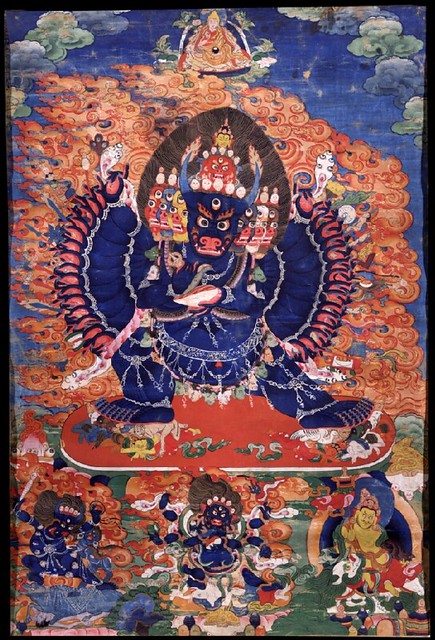
Indian Buddhism saw a rise in the popularity of Yamantaka iconography. Among the greatest fears of the Buddhist practitioner was the possibility of a lifetime or lifetimes spent in the narakas (Jp: jigoku), or Buddhist hells. So it follows that the worship of a deity who represented victory over death and the dominance of wisdom over ignorance would enjoy some prominence. Yamantaka was known by several other names: among them Yamari, which means “Adversary of Yama,” and Vajrabhairava. It is by the latter that he is known in Tibet, where he is most commonly depicted in his buffalo-headed form. There are certainly exceptions where a buffalo motif is instead included in his crown, as a vehicle, or elsewhere near his person, but these are rare. The three most popular forms are the Vajrabhairava with nine heads, 34 arms, and 16 legs; the six-headed, six-armed, six-legged Vajrabhairava of the Kalacakra (turning of the Wheel) tantra; and the four-headed, eight-armed, and four-legged Vajrabhairava. In Tibetan mandala paintings—which come in single, 13, or 49 deity variants—Vajrabhairava has blue-black skin. The buffalo head is central and often wears a crown topped with a model of Manjushri’s head. His legs form the destructive pratyalida stance, which we also see utilized by Trailokyavijaya in the latter’s trampling and humiliation of Mahesvara and Umadeva. This is perhaps due to their connection as “subjugators:” the former of Hindu deities, the latter of death itself.
In Bodh Gaya, India, there is hidden from public view a pair of sculptures depicting Trailokyavijaya and Yamantaka; the latter is shown standing atop a buffalo with his, as Robert Linrothe observes, iconographically identifiable six legs. A similar sculpture is seen in Nalanda. These both date to the ninth or 10th centuries, but it is likely the iconography could have appeared even earlier as the sutras were written and translated. A third ninth or 10th century sculpture of Yamantaka was also found in Kuruma, but this one is of the four-headed, eight-armed, and four-legged variant. Chinese images of Yamantaka vary dependent on the Buddhist tradition: some follow the six-armed form, others the 34-armed. It is the six-armed form which Kūkai and Saichō encountered in China during their early ninth-century visits, and which was then transmitted via scriptures, diagrammatic drawings (Jp: zuzō), and mandalas to Japan.
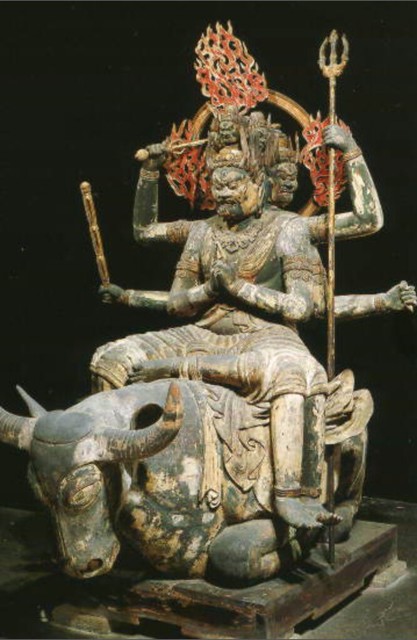
Both Kūkai’s Shingon and Saichō’s Tendai schools of Japanese esoteric Buddhism (Jp: mikkyō) include Daiitoku myōō among sculptural and painted representations of the godai myōō. He is also given his own mandala, which was utilized especially by warriors about to go to battle. To have the Destroyer of Death on one’s own side when facing the mortality of the battlefield would have certainly been a boon. Beautiful examples of Daiitoku can be found in temples across the country, but most famously at Tō-ji as part of Kūkai’s three-dimensional representation of the Nin’no-gyo mandara (Mandala of the Humane Kings in Defense of the Nation). There, Daiitoku myōō sits with six legs—two crossed in front of him, the remaining four pendant—on a buffalo. His six arms form the mudra of restraint (Jp: konpon-in) and hold various implements, while his six heads look in all directions with expressions of disgust, anger, and resolve.
References
Bond, Kevin. 2001. “Ritual and Iconography in the Japanese Esoteric Buddhist Tradition: The Nineteen Visualizations of Fudo Myoo.” Thesis. McMaster University.
Buswell Jr., Robert and Donald S. Lopez Jr. 2013. Princeton Dictionary of Buddhism. Princeton, New Jersey: Princeton University Press.
Hiromitsu, Washizuka. 1997. Enlightenment Embodied: The Art of the Japanese Buddhist Sculptor (7th-14th Centuries). New York: Agency for Cultural Affairs (Bunka-Cho), Government of Japan, Japan Society.
Linrothe, Robert. 1999. Ruthless Compassion: Wrathful Deities in Early Indo-Tibetan Esoteric Buddhist Art. London: Serindia Publications.
Parent, Mary N. and Malcolm Parent. 2003–18. Japanese Architecture and Art Net Users System (JAANUS).
Watt, Jeff. 1998–2018. Himalayan Art Resources (HAR). Website: www.himalayanart.org





